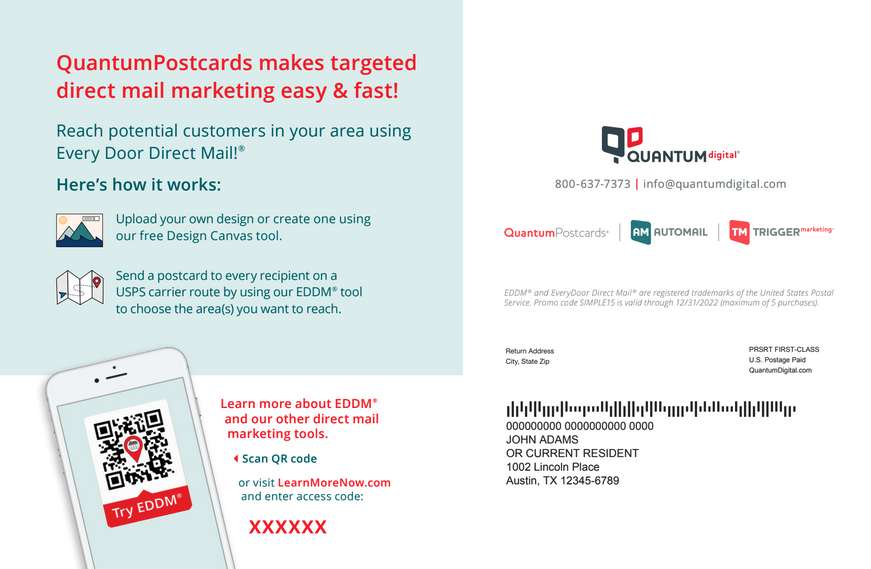How to Create a Killer Direct Mail Call to Action
You’ve crafted the perfect direct mail postcard. It’s well-written, well-designed, benefits the audience, AND is being sent to the appropriate targeted list of recipients. You’re proud of this campaign and can’t wait to see the results!
Yet, weeks after it’s mailed out, you still have few leads: no website visits, phone calls, or new customers. What went wrong?
There are many reasons a campaign doesn’t elicit the desired response from your audience. But when every other element of the direct mail piece is executed flawlessly and all you hear are crickets, the culprit is likely a poor call to action.
If an interested recipient doesn’t know what to do after they’ve read your mailer, they normally will just throw it in the trash. Putting a clear call to action on your mailer ensures that your audience can respond in the way you want them to, whether that’s buying a new product, making a phone call, visiting a website, or attending an event.
Selecting a call to action is arguably the most important part of any direct mail campaign.

Answering the following questions will help you design a great call to action that is better positioned to achieve your desired results.
What is the purpose of your campaign?
It may seem standard, but before writing any copy for your next marketing postcard, you should consider its purpose.
- Why are you sending out this direct mail piece?
- Are you hoping to raise awareness around your brand?
- Do you want to encourage purchases by informing your audience about a sale?
- Are you interested in getting their feedback on a new product or company feature?
All marketing postcards should be created with the intention that the direct mail piece is actionable; this will entice your audience into taking action. All copy in the mailer should be created with this end goal in mind, not just the call to action.
What action do you want your audience to take?
Before designing any mail piece, consider what action you want your audience to take and choose only one.
While putting multiple calls to action in your campaign may sound like a good idea, it’s important to focus on a single action within a single direct mail postcard. Multiple calls to action can confuse your reader and muddy the purpose of the campaign.
Think about how you sort through your own mail: you likely go through the entire process in seconds, skimming the headlines and images to determine if it’s relevant or interesting to you. A single, standout call to action is easier to comprehend for the reader, and more likely to grab attention than multiple messages scattered throughout the piece. Keep it simple!
If you aren’t sure which call to action you should use, consider conducting some A/B testing to find out what works best for your brand and product.

What does a call to action look like?
When creating a call to action for a direct mail campaign, employ these best practices to keep the copy punchy and engaging.
- Begin with a verb. Using a verb at the beginning of a sentence keeps the copy active and inherently easier to understand. As an example, every bullet point in this list begins with an active verb.
- Convey a sense of urgency. Using words and phrases such as “now”, “today” and “last chance” push the reader to respond sooner rather than later.
- Indicate a clear benefit. What does the recipient stand to gain from your offer? Make sure it’s clearly listed in your campaign.
Below are a few examples:
Objective: Secure attendees for an event
Call to Action: "RSVP in the next 24 hours to save with early bird pricing!"
Objective: Gain new subscribers for a retail company’s email newsletter
Call to Action: "Subscribe today for regular updates on the latest trends and exclusive deals."
Objective: Increase patient roster of a medical practice
Call to Action: "Contact us now for a FREE consultation!"
Incorporate this structure into your next call to action, and you’ll be well on your way to a compelling mail piece.
What color should you use?
There are many opinions on which color generates the most conversions. A general rule of thumb is to pick a call to action color that is complementary to the dominant color used: the call to action should be that color’s opposite on the color wheel. This will create contrast and make the call to action stand out.
However, always remember your brand: you don’t want to choose a color just for the sake of contrast that doesn’t fit your brand’s personality or the direct mail postcard’s color scheme.
These tips will help you create calls to action that have a clear message, are interesting and beneficial to the user, and are visually appealing. Following the above call to action guidelines can increase returns and motivate your audience to respond in the way you desire.
If you’re ready to start designing your next marketing postcard incorporating these tips, we provide an easy-to-use tool for creating beautiful, high-quality direct mail pieces: Design Canvas. This tool allows you to make your own postcard without the need for a designer, and it’s simple to use. Check it out today -- we can’t wait to see what you come up with!
Share to:
